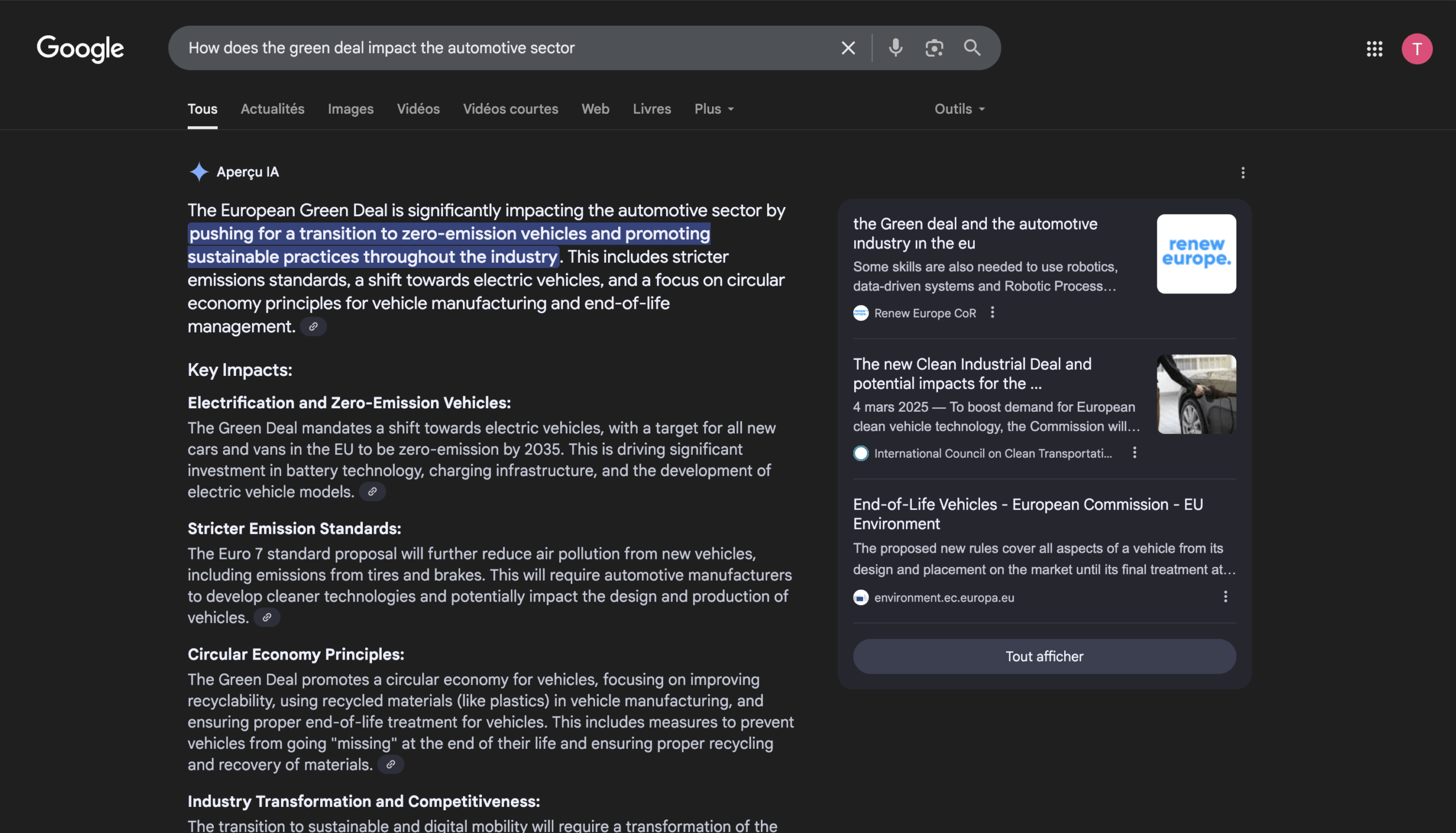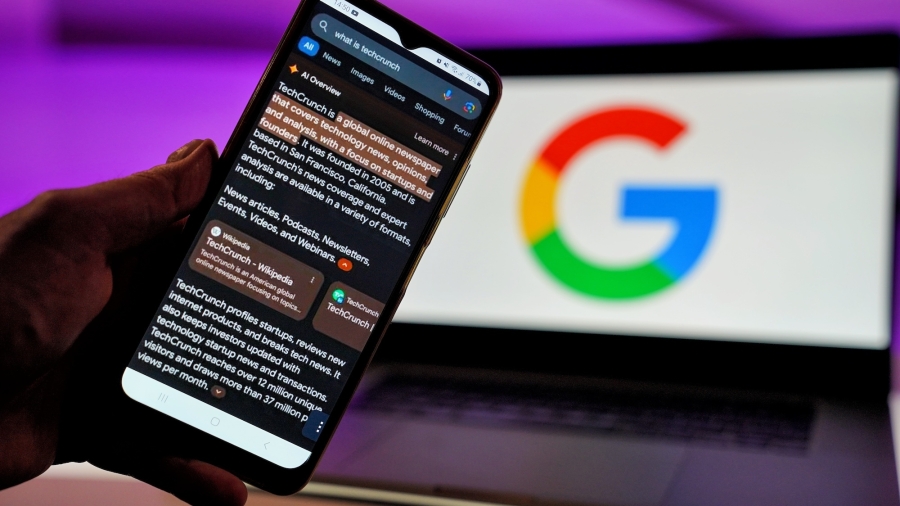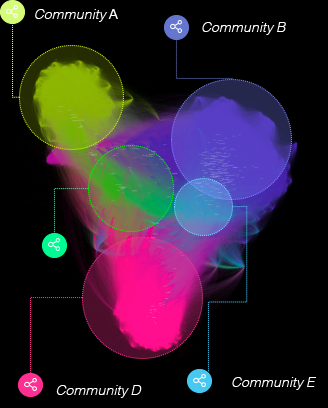Why AI overviews matter for EU associations
If you’ve searched on Google recently and seen a boxed summary answer at the very top, you’ve likely encountered an AI Overview. Google’s AI Overview “summarize[s] information from multiple sources to provide direct answers to user queries while offering relevant links”. In other words, Google’s AI scans the web and presents a quick composite answer, with citations, to help users “quickly understand information from a range of sources”. For our audience – European associations and advocacy bodies – this feature is a big deal.
Being featured in an AI Overview means your organization’s content becomes the instant answer to someone’s query. It’s prime real estate on the results page: the AI summary sits at the very top, often above all traditional results. This prominence can significantly boost your visibility and credibility. In fact, being cited in an AI Overview can dramatically increase click-through rates for your content, even if you weren’t ranking on page one before. One recent study noted that while about 52% of AI-cited sources were already top-10 Google results, nearly half of them were pulled from beyond the first page. In practical terms, this means even if your site isn’t #1 in regular SEO, a strong piece of content can still get spotlighted by Google’s AI. That’s a game-changer for associations trying to punch above their weight online.
Why does this matter for EU-focused organizations in particular? Associations and NGOs often produce high-value research, policy papers, and data – exactly the kind of authoritative content that Google’s AI might draw on to answer complex questions. Whether it’s a summary of new climate targets, a statistic about industry employment, or an explainer of EU legislation, you want your insights to be the ones the AI showcases. Not only does this help drive traffic to your reports, it also positions your organization as a thought leader (“Google itself is quoting us!”). In advocacy and influence-building, that kind of implied endorsement is priceless.

Finally, consider user behavior: many people, especially policymakers or researchers in a hurry, will read the AI’s overview and only click through if they need more detail. If your perspective isn’t reflected in that overview, you risk being overlooked. In contrast, if the AI mentions your organization by name or cites your data, you’ve immediately gained trust and attention. For EU trade bodies aiming to shape legislation or grow membership, being visible in these AI summaries helps ensure your narrative isn’t left out of the conversation.
How to get your content featured in AI overviews
Google has said there’s no special trick – “nothing special for creators to do to be considered” aside from following good SEO practices. In reality, there are strategic steps you can take to increase your chances. It boils down to structuring your content in a way that makes it easy for Google’s generative AI to recognize its value and trustworthiness. Here are some high-level tactics to help your association’s content shine in AI Overviews:
- Answer Specific Questions with Context: Focus on informational queries relevant to your mission, and make sure your content directly answers them in depth. AI Overviews are triggered by people asking detailed questions (according to one analysis, about 99% of the time they come from “informational” searches). So, structure your articles, white papers, or blog posts around the key questions your audience (or the general public) might ask. For example, if you’re an environmental lobby, an article titled “What are the EU’s 2030 carbon reduction targets?” should clearly state the targets and provide context (Why 2030? How do these targets compare globally? etc.). Google’s AI rewards content that is well-contextualized and easy to read, meaning you should give enough background for a stand-alone answer. The more directly and comprehensively you address a question, the more likely the AI will pull from your text to form its overview.
- Use Structured Formatting (and Markup): Structure isn’t just for human readers – it’s for the algorithms too. Well-organized content helps Google’s AI digest your points. This means using clear headings, subheadings, bullet points, and concise paragraphs to break down information. In fact, SEO experts have found that well-structured content – with bullet lists and clear sections – is often favored by AI Overviews. Think of it this way: if your page is skimmable and scannable, it’s easier for the AI to identify the key pieces to highlight. Consider adding summary sections or FAQ-style Q&A on your pages for common questions. On the more technical side, implementing structured data (schema markup) can give you an extra edge. This is code (invisible to readers) that explicitly tells search engines what your content is (an article, a report, a FAQ, etc.) and what it contains. By adding schema markup – for example, marking up a Q&A section with FAQ schema or using Article schema on your report pages – you help Google understand the context of your content. This makes your page more likely to be included in AI Overviews. It’s not an overly technical detail to worry about here, but it’s good to know that structured content + structured data = easier for AI to trust and quote your page. (If terms like schema sound intimidating, don’t worry – this is exactly the kind of detail a digital strategy expert can handle for you, which we’ll touch on later.)
- Establish Authority and Credibility: Authoritative content is king in the age of AI. Google’s systems choose sources for AI summaries based on credibility and relevance – so you need to demonstrate both. What does that mean for an association’s website? First, write in an authoritative tone – be confident and factual in your language. Back up your statements with data (if you have a compelling statistic, feature it prominently) and cite sources when appropriate. Showing that your content is well-researched can only help the AI view it as reliable. Second, leverage your organization’s expertise: include author bylines with titles/credentials on blog posts or reports, and have an “About” page that highlights your history and mission. Google assesses experience, expertise, authority, and trustworthiness (E-E-A-T) as it evaluates content. If, say, a policy brief on your site is written by a known expert or your association has a strong track record in that field, make sure that’s visible. Also, your broader reputation on the web matters. Content from sources that are frequently cited elsewhere or mentioned by other trusted publications is more likely to be included in AI Overviews. Think about it: if many reputable sites or news outlets refer to your reports, Google’s AI gains confidence that you’re a trusted source. This is a longer-term play, but it reinforces the value of publishing high-quality content that others will quote, and engaging in a bit of digital PR (e.g., getting your research featured in industry news). In short: be the expert and show it off. Use an authoritative voice, present evidence, and build your site’s credibility so that Google’s AI sees you as a go-to reference on your topics.
- Keep it Plain and People-Friendly: While you want to sound authoritative, you also want to be accessible. Avoid heavy jargon or overly bureaucratic language – content that reads like a dense legal brief might be accurate, but Google’s AI might struggle to distill it for a quick answer. Write as if you’re explaining the topic to an informed colleague from another field. Use clear, straightforward language and define any necessary acronyms or technical terms. The benefit is twofold: you’ll engage human readers and make it easier for the AI to parse your text correctly. Google’s own guidance suggests content written in “a simple, easy-to-read format” tends to perform better in AI-generated responses. Think of how you’d summarize your main point in a tweet or a headline – then ensure that essence is front and center in your content. By all means, dive into detail (after all, adding context is important), but lead with clarity. A good tip is to include a short intro or conclusion in your article that sums up your key findings or stance. Often, that’s the part an AI might grab first. If your association publishes a 50-page report, consider also publishing a one-page executive summary or a blog post that highlights the major insights in plain language. This gives the AI a tidy “cheat sheet” to work with, increasing the odds it will quote your perspective correctly.
- Stick to SEO Best Practices – and Stay Fresh: AI Overviews don’t exist in a vacuum; they’re built on top of Google’s normal search index. That means the classic SEO fundamentals still apply. A well-optimized page (with a descriptive title, relevant keywords naturally included, proper meta description, etc.) is more likely to rank well in traditional search and thus be in the pool of content the AI draws from. In fact, over half of content cited in AI Overviews comes from the top 10 traditional search results for that querysearchenginejournal.com. So, you should still aim to follow basic SEO guidance: do some keyword research around the questions your audience is asking, optimize your page titles and headings accordingly, and ensure your site is technically healthy (mobile-friendly, fast-loading, and indexed by Google). Additionally, keep your content up-to-date. Google’s AI tends to favor information that is fresh and relevantsearchenginejournal.com. If you published a “State of the Industry 2022” report, consider updating it for 2023 or adding new commentary when new data comes out. Regularly updating your blog with timely posts (e.g. reacting to a new EU policy proposal) can also signal that your site has current info. An AI Overview answering a question like “What’s the latest on EU energy policy?” will look for the most recent insights. By maintaining a steady flow of updated content, you increase the likelihood that your site has that recent nugget of info the AI wants to share. And don’t forget to monitor and polish older evergreen content too – if something from two years ago is still relevant, make sure it’s still accurate and consider adding a brief update paragraph so Google knows it’s been reviewed. All these little SEO and content hygiene steps contribute to a better chance of being the chosen source when the AI summarizes a topic.
From theory to practice: Who’s getting cited?
You might be thinking, “This sounds good in theory, but is it really my association’s content that will show up, or just Wikipedia every time?” It’s true that big authorities like Wikipedia often appear in AI Overviews, but they’re not alone. Google’s AI is learning to pull from a diverse range of sources, provided they’re relevant and trustworthy. In fact, studies have shown that Google has been tweaking its AI to prioritize reputable websites over forum posts after some early hiccups. (One much-publicized blunder had the AI citing an old Reddit joke about putting glue on pizza – after that, Google understandably dialed down the reliance on unvetted forums!) A June 2024 analysis found that domains like LinkedIn and Wikipedia were among the most-linked sources in AI Overviews, whereas Reddit had faded from the top 10. By 2025, further research confirmed that while forums still sneak in for niche queries, Google’s AI Overviews heavily feature well-known informational sites and expert content (for example, Healthline for medical info, or official reference sites in various niches).
The takeaway: authoritative, well-structured content from established organizations is getting its moment in the AI spotlight. This is great news for associations and research bodies. You don’t have to be as ubiquitous as Wikipedia to be chosen. If your site has the most relevant, credible answer on a specific query, Google’s generative AI wants to include it. We’ve already seen instances of niche expertise rising to the top. For example, an SE Ranking study noted that specialized sites like RunnersWorld (for running statistics) and Healthline (for health topics) emerged as top-linked domains for relevant AI Overview queries. That happened not because they’re giant platforms, but because they had content that clearly and reliably answered the user’s question.
Now, imagine a policy-related scenario: a user asks, “How many plastic recyclers are there in Europe?” An AI Overview might scan for a statistic to answer that. If your association (say, a European recycling industry group) published a recent study with a headline finding like “Europe has 1,200 active plastic recycling facilities as of 2025,” and you’ve presented that info in a clear format, there’s a real chance the AI could pick it up. The overview might then read something like: “Europe has over 1,200 plastic recycling facilities【YourSite†source】, according to a 2025 report by the European Plastics Association…” – giving your organization a prominent shout-out. We’re already seeing AI Overviews citing EU agencies and reputable NGOs for environmental and health queries, because those organizations hold the trusted data. This is exactly where you want to be: featured as a key source when someone (be it a citizen, journalist, or policymaker) asks a question in your domain.
The broader impact of being featured is not just a traffic boost, but a credibility boost. If Google’s AI consistently references your publications, it reinforces in readers’ minds that your association is the place to go for that subject. It’s like becoming part of the digital fabric of knowledge on your issue. For advocacy groups trying to shape narratives, that visibility is invaluable.
Wrapping up: The expert advantage
By now, you might be eager to implement these tactics – and you absolutely should. The good news is that many of the steps (writing clear content, structuring it well, highlighting your expertise) are straightforward and align with what you’re likely already aiming to do. However, executing a truly effective strategy that bridges SEO, AI optimization, and content structuring can get complex. The search landscape is evolving fast, and the technical nuances (like schema markup, content audits, AI query research) might feel a bit overwhelming on top of your day-to-day communications work.
This is where partnering with digital strategy experts can make all the difference. At FASTLN, we specialize in helping EU-focused organizations navigate exactly these kinds of challenges. We stay on top of the latest changes in Google (algorithms, AI features, you name it) so you don’t have to. Working with an experienced team means you get to shortcut the learning curve – we can assess your current site, identify content opportunities for AI Overviews, implement the necessary technical tweaks, and even help craft new content targeted at those high-impact questions. Essentially, we handle the behind-the-scenes orchestration to ensure your valuable content gets the spotlight it deserves.
Remember, dominating AI Overviews isn’t about gaming the system; it’s about demonstrating your value in a format the system prefers. With a smart strategy and expert execution, your association can achieve that. You produce the high-value reports and insights that drive your mission – and by following the principles above (and with a little help from folks who live and breathe digital strategy), you can amplify that work to grow your influence in this new era of AI-powered search. The bottom line: AI Overviews matter, and with the right approach, they’re an opportunity – your opportunity – to lead the conversation. If you’re ready to seize it, we’re here to help you make it happen.




